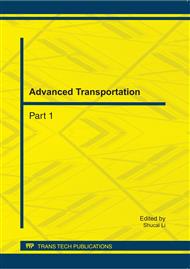p.108
p.114
p.121
p.130
p.138
p.146
p.151
p.156
p.162
Effects of Design and Construction Factors on Continuously Reinforced Concrete Pavement Performance
Abstract:
In order to study the effects on the performance of continuously reinforced concrete pavement (CRCP) of some factors, eleven CRCP test sections were designed and constructed in Yanwei Expressway in China. The factors considered included concrete material, base configuration, epoxy coated of steel, transverse steel orientation, the depth of longitudinal reinforcement and the active cracks spacing. Concrete properties tests, early age cracking monitor and falling weight deflectometer tests were all carried out in these test sections. Furthermore, the field investigations to several other CRC pavements having been open for years in China were carried out also and cluster cracking and punchout distress were considered as the performance criteria of CRCP. Finally, the effects on CRCP performance of some factors were discussed. Results show that, the CRCP performance when the separating layer between the concrete slab and cement treated base is asphalt concrete is better than that when the separating layer is paraffin, and the thicker the asphalt mixture separating layer the better the CRCP performance; the modification of transverse steel skew angle can improve the CRCP performance; the concrete material, transverse steel skew and base have more effects on cluster cracking than the separating layer between concrete slab and base does; and the active cracks at the spacing of 1 to 5 m can prevent the occurrence of natural cracks between them.
Info:
Periodical:
Pages:
138-145
Citation:
Online since:
September 2011
Authors:
Keywords:
Price:
Сopyright:
© 2011 Trans Tech Publications Ltd. All Rights Reserved
Share:
Citation:


